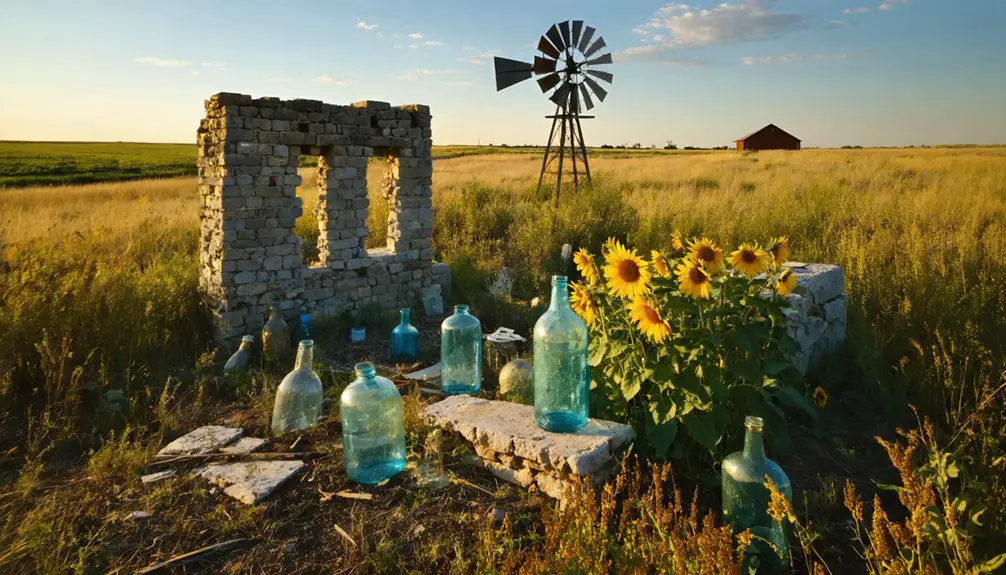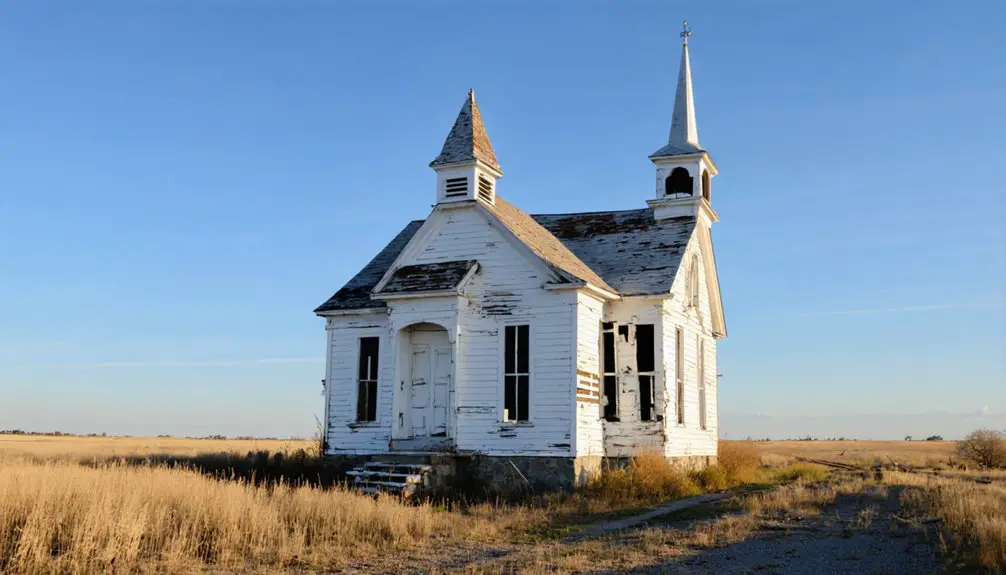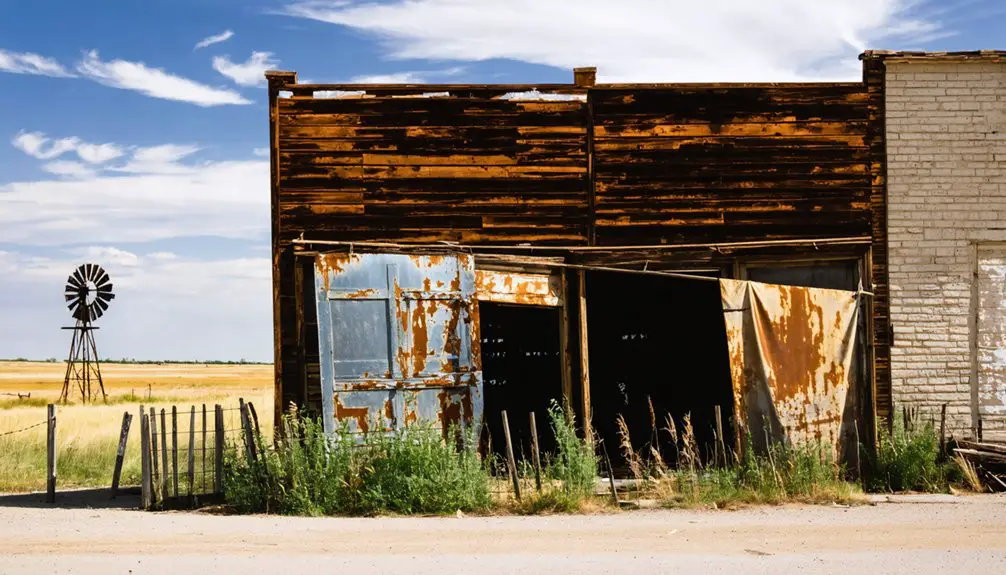You’ll find Stringtown (later Woodstock) in Cherokee County, Kansas, where the first underground coal mine shaft opened in 1874. The boomtown quickly grew to house 600-900 residents, featuring hotels, saloons, churches, and a schoolhouse. Steam-powered mining operations and railroad connections fueled its economy until cheaper coal elsewhere triggered its decline. Today’s ghost town tells a complex tale of immigrant workers, dangerous mining conditions, and a once-thriving frontier community.
Key Takeaways
- Stringtown emerged as a bustling coal mining community in southeast Kansas during the 1870s, attracting diverse immigrant workers and fostering economic growth.
- The town’s social life centered around saloons, dance halls, and churches, serving a population of 600-900 residents during peak operations.
- Mining operations utilized steam-powered equipment and room-and-pillar methods, with multiple railroad sidetracks supporting industrial activities.
- Economic decline began when cheaper coal deposits emerged elsewhere, leading to mine closures and mass exodus of workers.
- The town’s transformation into a ghost town resulted from combined factors of mining decline, transportation changes, and insufficient agricultural alternatives.
The Rise of a Mining Frontier
When the first underground coal mine shaft in southeast Kansas was built near Scammon in 1874, it marked the beginning of a transformative era in the region’s mining frontier.
You’ll find that mining technology quickly evolved, with steam-powered hoisting equipment and double entry shafts becoming standard features by the late 1870s. The room-and-pillar method dominated operations, though some mines like the Kansas State Penitentiary opted for longwall mining techniques.
Underground mining in Kansas advanced rapidly, with steam hoists and dual shafts transforming coal extraction methods throughout the 1870s.
Early settlers like Marion Medlin and Dosser were among the first to extract coal from surface outcroppings, trading it for essential supplies and groceries.
As word spread about the high-quality coal in the region, you’d have witnessed a surge of immigrant workforce arriving from Europe and the East Coast throughout the 1880s and 1890s. The state employed an average of 445 inmates at the Kansas State Penitentiary mine during peak operations.
Mining camps and frontier towns sprouted rapidly around successful operations, while railroads expanded to connect these bustling communities, fueling both literal and economic growth in southeast Kansas.
Life in a Kansas Boomtown
If you’d visited Stringtown in its heyday, you’d have witnessed miners working grueling shifts in the local mines while merchants and saloon-keepers served the bustling community from dawn till dusk.
Like the notorious Kansas cowtowns before it, the town developed a reputation for lawlessness and decadence that attracted a rough crowd.
You’d have found the town’s social life centered around dance halls and saloons where miners, Civil War veterans, and Eastern entrepreneurs mingled, gambled, and conducted business deals.
The town’s diverse mix of settlers, including Native Americans and African Americans, created a vibrant marketplace where local newspapers promoted new opportunities and telegraph offices kept residents connected to the outside world.
Similar to the bustling port of Quindaro at its peak, Stringtown’s population swelled with diverse settlers seeking economic opportunities in the region.
Mining Workers’ Daily Routines
Life as a miner in Stringtown and Woodstock demanded extraordinary physical endurance, starting with pre-dawn wake-up calls that echoed through the makeshift housing settlements.
Your mining routines would follow a strict schedule in harsh conditions, where every moment counted in the race for precious minerals. With limited amenities in these primitive mining camps, diseases and pests were constant challenges for workers. Much like in Empire City, the quest for lead and zinc drove the intensive mining operations.
- You’d head to the communal kitchen for a simple but filling breakfast before your dawn-to-dusk shift.
- Worker camaraderie helped you endure the physical strain and dangerous conditions underground.
- You’d take brief breaks throughout the day, sharing meals with fellow miners.
- After your shift, you’d likely join others at the local saloon to unwind.
Despite the grueling nature of the work, you’d find comfort in the shared experiences and social bonds formed with your fellow miners, creating a tight-knit community within these Kansas boomtowns.
Community Social Activities
Despite the demanding nature of mining work, Stringtown and Woodstock’s social life thrived through various community gatherings and recreational activities.
You’d find locals congregating at taverns and dance halls, while churches hosted regular socials and charity events. During warm months, community picnics along the river offered a welcome escape from daily routines.
The towns came alive with seasonal fairs, complete with games, food vendors, and live music.
You could join card games and billiards at social venues, or participate in outdoor sports like baseball and horseshoe pitching.
Amateur theater performances and traveling shows provided entertainment, while literary clubs and reading groups fostered education.
When hardship struck, you’d witness the community’s strength through volunteer fire brigades and ladies’ aid societies that supported those in need.
Local Business Operations
The economic heartbeat of Stringtown and Woodstock centered on bustling enterprises that lined the railroad tracks. Local commerce thrived through natural resource industries and agricultural ventures, creating a self-sustaining economy.
You’d find crucial services that kept the town’s business operations flowing:
- The bank managed financial transactions while the post office (est. 1874) handled critical communications
- Cotton gins processed local harvests, and lumber companies maximized timber resources
- Southwest Stone Company’s rock crusher provided steady industrial employment
- Blacksmith shops, mercantile stores, and cafes served daily needs
The town utilized multiple sidetracks for loading goods onto trains, maximizing shipping efficiency. Business resilience faced its greatest test during the 1951 flood, which devastated many establishments. While some businesses never recovered, the community’s entrepreneurial spirit endures today through new cafes and small enterprises, though not matching its boomtown peak. Many local establishments have adopted modern quick login options to serve their customers more efficiently.
Mining Operations and Economic Impact
When the Scammon brothers pioneered Cherokee County’s first deep mine shaft in 1874, they established a revolutionary underground mining operation that would transform Kansas’s mineral industry.
Their mining innovations proved skeptics wrong, as the room-and-pillar system thrived even in shallow mines. You’ll find their impact reflected in the region’s economic transformations, with mines evolving from modest beginnings to operations producing 40 carloads daily.
The revolutionary room-and-pillar mining system transformed modest operations into thriving enterprises, defying early doubters and boosting regional production exponentially.
The Weir-Pittsburg coal vein became the state’s most extensively mined deposit, yielding over 200 million tons throughout its history. The 40-inch thick seam made it one of the heaviest coal beds in Kansas.
Mining operations varied in depth and technique, from 25 to 75-foot shafts in Minersville to numerous strip mines across the region. This robust mining activity supported railroad expansion, fueled commerce, and established thriving communities that served as essential distribution hubs for workers and resources. Stone City stood out among these communities with its well-maintained houses that the company provided to its workers.
Community Structure and Daily Life

You’d find the social fabric of Stringtown/Woodstock woven through its four churches and schoolhouse, where mining families gathered for worship and education until 1964.
The town’s businesses, including hotels, bars, a doctor’s office, and general stores, served the daily needs of 600-900 residents during the peak mining era.
While churches and the school provided structured community engagement during the day, the town’s nightlife centered around bars and public houses, operating with minimal law enforcement oversight.
Mining Families’ Social Activities
Mining families in Stringtown/Woodstock developed rich social networks that revolved around their demanding work schedules and shared challenges. The community’s resilience shone through their mutual aid systems, where you’d find women organizing informal networks for childcare and resource sharing while men worked eight-hour underground shifts.
- Social clubs and union halls served as gathering spots for entertainment and political organizing.
- Local celebrations featured patriotic events, hymns, and public gatherings to relieve work stress.
- Sports events and outdoor games brought both children and adults together.
- Church activities and school functions strengthened family bonds.
These social activities weren’t just about entertainment – they helped mining families cope with dangerous working conditions and economic uncertainties.
Through collective support and organized activities, you’d see how the community maintained its spirit despite daily hardships.
Local Business and Commerce
Beyond the tight-knit social fabric of Stringtown/Woodstock lay a bustling commercial district that supported its hardworking residents.
You’d find multiple general stores stocking daily essentials, while hotels and bars catered to miners and travelers passing through. The local market thrived with professional services, including doctors and judges, while a post office facilitated trade and communication.
As mining operations flourished, up to ten saloons operated in the area, creating a lively atmosphere despite the lack of formal law enforcement.
However, commercial decline set in as mining activities dwindled and railroads bypassed the town. Though some residents attempted to shift to farming and ranching, it wasn’t enough to sustain the once-vibrant business community.
Today, only scattered foundations and a few houses remind visitors of the town’s commercial past.
Church and School Life
While life in Stringtown/Woodstock centered on resource extraction, the town’s social fabric was woven through its churches and schools.
You’d find multiple churches serving as both spiritual centers and community gathering spaces, while the school operated from the early to mid-1900s, fostering education and social connections.
Daily life revolved around these essential institutions, where you’d experience:
- Regular church gatherings that brought families together for worship and fellowship
- School events that united the community, from academic programs to town meetings
- Informal governance through respected religious and educational leaders
- Shared cultural experiences through seasonal festivals and celebrations
These institutions helped maintain community stability during economic ups and downs, though eventually both churches and schools closed as the population dwindled, marking the town’s shift to ghost status.
The Path to Abandonment

As the 20th century unfolded, Stringtown/Woodstock’s fate became increasingly tied to the decline of its two primary strip mines. When cheaper coal deposits emerged elsewhere in Kansas, the town’s economic foundation crumbled.
You’d have witnessed dramatic economic shifts as mining operations ceased, triggering a mass exodus of workers seeking employment elsewhere.
The town’s population dynamics changed rapidly. From a vibrant community of over 600 residents, you’d have seen stores closing and families moving away. By 1964, even the school had shut its doors.
Transportation changes dealt another blow – while the railroad once brought prosperity, new highways redirected commerce elsewhere. Natural disasters and environmental challenges from mining further deterred resettlement.
The combination of these factors transformed this once-thriving mining town into a ghost town.
Legacy and Remnants Today
Today when you visit Stringtown/Woodstock, you’ll find scattered remnants of its mining-era glory. The ghost town‘s landscape tells the story of its past through surviving structures and mining scars, while local historical preservation efforts keep its memory alive.
- The original schoolmaster’s house and church building still stand as silent witnesses to the once-thriving community.
- Coal weighing foundations and abandoned houses dot the terrain, marking former centers of activity.
- Mining’s environmental impact remains visible in the soil, though much land has transformed for agricultural use.
- Historical markers, primarily cemeteries, provide evidence to those who once called this place home.
You can explore these remnants yourself, though you’ll find limited facilities and mostly informal, self-guided access to this piece of Kansas history.
Frequently Asked Questions
Are There Any Documented Paranormal Activities in the Abandoned Buildings?
While you might expect ghost sightings in these empty structures, there aren’t any documented paranormal activities or haunted locations. The buildings remain silent witnesses to history, leaving mysteries unexplored.
What Happened to the Mining Equipment After the Town Was Abandoned?
You’ll find most mining equipment was either relocated to active mines, salvaged for scrap metal, or left to decay. Companies moved valuable machinery while smaller pieces were scavenged by locals over time.
Did Any Famous Outlaws or Historical Figures Visit the Town?
Like a tumbleweed drifting through history, you won’t find concrete evidence of famous outlaws or historical figures visiting here. Records don’t support any outlaw legends or significant historical visits.
Where Did Most of the Former Residents Relocate After Leaving?
You’ll find that former residents’ historical relocation patterns led them to nearby active mining towns, while others embraced residential migration to larger Kansas cities or turned to farming in surrounding rural areas.
Are There Any Preserved Artifacts From the Town in Nearby Museums?
You won’t find many artifacts on display, as historical preservation efforts weren’t well documented. While local historical societies and mining museums might house some items, there’s no confirmed collection specifically from this town.
References
- https://www.hhhistory.com/2019/05/ghost-towns-of-kansas.html
- https://www.youtube.com/watch?v=iB5rHT14eVI
- https://www.youtube.com/watch?v=alC1wDdSVvg
- https://legendsofkansas.com/everyplace-in-kansas-s/
- https://en.wikipedia.org/wiki/List_of_ghost_towns_in_Kansas
- https://www.ksgenweb.org/archives/crawford/history/1905/101.html
- https://legendsofkansas.com/coal-mining-in-kansas/
- https://geokansas.ku.edu/coal-mining
- https://www2.ljworld.com/news/2007/mar/20/minings_legacy_scar_kansas/
- https://www.dot.ga.gov/InvestSmart/Environment/CulturalResources/Pubs/MiningContextFinalReduced.pdf



